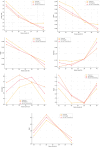Detail-preserving denoising of CT and MRI images via adaptive clustering and non-local means algorithm
- PMID: 40615516
- PMCID: PMC12227602
- DOI: 10.1038/s41598-025-08034-x
Detail-preserving denoising of CT and MRI images via adaptive clustering and non-local means algorithm
Abstract
Medical imaging systems such as computed tomography (CT) and magnetic resonance imaging (MRI) are vital tools in clinical diagnosis and treatment planning. However, these modalities are inherently susceptible to Gaussian noise introduced during image acquisition, leading to degraded image quality and impaired visualization of critical anatomical structures. Effective denoising is therefore essential to enhance diagnostic accuracy while preserving fine details such as tissue textures and structural boundaries. This study proposes a robust and efficient denoising framework specifically designed for CT and MRI images corrupted by Gaussian noise. The method integrates a cluster-wise principal component analysis (PCA) thresholding approach guided by the Marchenko-Pastur (MP) law from random matrix theory and a non-local means algorithm. Noise level estimation is achieved globally by analysing the statistical distribution of eigenvalues from noisy image patch matrices and leveraging the MP law to accurately determine the Gaussian noise variance. An adaptive clustering technique is employed to group similar patches based on underlying features such as textures and edges and enables localized denoising operations tailored to heterogeneous image regions. Within each cluster denoising is performed in two stages where initially hard thresholding based on the MP law is applied to the singular values in the SVD domain to obtain a low-rank approximation that preserves essential image content while removing noise-dominated components. Residual noise in the low-rank matrix is then further suppressed through a coefficient-wise linear minimum mean square error LMMSE estimator in the PCA transform domain. Finally, a non-local means algorithm refines the denoised image by computing weighted averages of pixel intensities and prioritizing neighbourhood similarity over spatial proximity to effectively preserve edges and textures while reducing Gaussian noise. Experimental evaluations on CT and MRI datasets demonstrate that the proposed method achieves superior denoising performance while maintaining high structural similarity and perceptual quality compared to existing state-of-the-art approaches. The method demonstrates adaptability noise reduction capability and preservation of anatomical detail that make it well suited for precision critical medical imaging applications.
Keywords: Adaptive clustering; CT imaging; Gaussian noise; Image denoising; Linear minimum mean square error (LMMSE); MRI imaging; Marchenko–Pastur law; Non-local means; Random matrix theory.
© 2025. The Author(s).
Conflict of interest statement
Declarations. Competing interests: The authors declare no competing interests.
Figures
















Similar articles
-
2-D Stationary Wavelet Transform and 2-D Dual-Tree DWT for MRI Denoising.Curr Med Imaging. 2025 Jul 7. doi: 10.2174/0115734056365765250630140748. Online ahead of print. Curr Med Imaging. 2025. PMID: 40626533
-
Denoising pediatric cardiac photon-counting CT data with sparse coding and data-adaptive, self-supervised deep learning.Med Phys. 2025 Jul;52(7):e17918. doi: 10.1002/mp.17918. Med Phys. 2025. PMID: 40660927
-
Preserving noise texture through training data curation for deep learning denoising of high-resolution cardiac EID-CT.Med Phys. 2025 Jul;52(7):e17938. doi: 10.1002/mp.17938. Med Phys. 2025. PMID: 40660962
-
Home treatment for mental health problems: a systematic review.Health Technol Assess. 2001;5(15):1-139. doi: 10.3310/hta5150. Health Technol Assess. 2001. PMID: 11532236
-
Magnetic resonance perfusion for differentiating low-grade from high-grade gliomas at first presentation.Cochrane Database Syst Rev. 2018 Jan 22;1(1):CD011551. doi: 10.1002/14651858.CD011551.pub2. Cochrane Database Syst Rev. 2018. PMID: 29357120 Free PMC article.
References
-
- Nazir, N., Sarwar, A. & Saini, B. S. Recent developments in denoising medical images using deep learning: An overview of models, techniques, and challenges. Micron180, 103615. 10.1016/J.MICRON.2024.103615 (2024). - PubMed
-
- El-Shafai, W., El-Nabi, S. A., Ali, A. M., El-Rabaie, E. S. M. & Abd El-Samie, F. E. Traditional and deep-learning-based denoising methods for medical images. Multimed. Tools Appl.83(17), 52061–52088. 10.1007/S11042-023-14328-X/METRICS (2024).
-
- Jifara, W., Jiang, F., Rho, S., Cheng, M. & Liu, S. Medical image denoising using convolutional neural network: A residual learning approach. J. Supercomput.75(2), 704–718. 10.1007/S11227-017-2080-0/METRICS (2019).
-
- Binh, N. T. & Khare, A. Adaptive complex wavelet technique for medical image denoising. IFMBE Proc.27, 196–199. 10.1007/978-3-642-12020-6_49 (2010).
-
- Satapathy, L. M., Das, P., Shatapathy, A. & Patel, A. Bio-medical image denoising using wavelet transform. Int. J. Recent Technol. Eng8(1), 2874–2879 (2019).
MeSH terms
LinkOut - more resources
Full Text Sources
Medical

